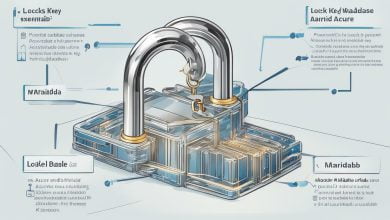
In the age of digitalization, online security is of paramount importance. The need for secure authentication and authorization protocols has led to the development of several standards such as OpenID, SAML, and OAuth. These standardized protocols help to establish secure communication between different services and applications, enhancing online security significantly.
OpenID, SAML, and OAuth have become widely accepted standards for web authentication and authorization, with each having its own unique characteristics and advantages. Understanding these standards’ roles in different scenarios is crucial in designing secure web applications that can offer seamless user experience.
Key Takeaways:
- OpenID, SAML, and OAuth are vital standards in web authentication and authorization.
- Each standard offers unique benefits and plays a crucial role in enhancing online security.
- Having a clear understanding of these standards is crucial in designing secure web applications and experiences.
Understanding OpenID
OpenID is an authentication standard that enables users to authenticate themselves on various websites using a single digital identity. It is designed to simplify the process of web authentication by allowing users to use a single set of login credentials across multiple websites and services.
The OpenID protocol is built on top of existing authentication standards, such as SSL/TLS and HTTP, and allows web applications to use OpenID-enabled providers to authenticate users. This is achieved through a series of exchanges between the user, the relying party (i.e., the website that needs to authenticate the user), and the identity provider (i.e., the entity that validates the user’s identity).
OpenID provides several benefits to both users and service providers. For users, it eliminates the need to create and remember separate login credentials for every website they visit, as well as the hassle of filling out registration forms. For service providers, it reduces the time and resources required to manage user accounts and passwords, as well as their liability for storing sensitive user information.
Key features and components of OpenID
OpenID is based on a decentralized architecture, meaning that it does not rely on a central identity provider to authenticate users. Instead, users can choose from a variety of OpenID providers, such as Google, Yahoo, or Facebook, or even set up their own OpenID provider.
To use OpenID, a user must first create an account with an OpenID provider and associate it with their digital identity. When the user attempts to access a website that supports OpenID authentication, they are redirected to their OpenID provider, where they authenticate themselves using their login credentials. The identity provider then sends a message back to the relying party, verifying the user’s identity.
OpenID also supports different levels of authentication assurance, depending on the sensitivity of the data being accessed. For example, a low level of assurance may be sufficient for accessing a non-sensitive website, while a high level of assurance may be required for accessing sensitive information such as financial data or medical records.
Overall, OpenID is a powerful authentication standard that simplifies the process of web authentication while enhancing data security. Its decentralized architecture and support for different levels of assurance make it a versatile tool for web developers and service providers.
Exploring SAML
SAML, or Security Assertion Markup Language, is a widely-used authentication standard in web applications. It provides a framework for exchanging authentication and authorization data between parties, such as an identity provider (IdP) and a service provider (SP).
The SAML protocol works by using XML-based messages to transmit assertions about a user’s identity and attributes between the IdP and SP. When a user requests access to a resource, the SP redirects them to the IdP for authentication. Once the user is authenticated, the IdP sends a SAML response to the SP with the user’s identity attributes.
One of the key advantages of SAML is that it enables Single Sign-On (SSO), allowing users to authenticate once and access multiple services without having to re-enter their credentials. This enhances both security and convenience for users. Additionally, SAML provides a high level of trust and security by allowing the IdP to confirm the user’s identity and attributes, preventing unauthorized access to resources.
The SAML protocol consists of several components, including assertions, protocols, bindings, profiles, and bindings. Together, these components provide a flexible and extensible framework for enhancing web authentication and authorization. SAML implementations are widely adopted by organizations and service providers for secure authentication and access control.
Understanding OAuth
OAuth is a standard authorization protocol that allows third-party applications to access a user’s data on different websites without revealing passwords. OAuth protocol is widely used to enable secure authorization between different services and applications. It allows users to grant or revoke access to their data in a controlled and secure manner, enhancing user privacy and control.
The OAuth protocol involves three main players: the user, the service provider, and the consumer. The user grants permission to the consumer to access their data stored on the service provider’s server. The consumer requests authorization from the service provider by presenting its credentials signed with its secret key. If the service provider verifies the authenticity of the credentials, it generates an access token, which the consumer uses to access the user’s data.
The OAuth protocol uses a token-based authentication mechanism, where the user’s password is not shared with the consumer. The token is a string of characters that represent the user’s authorization to access their data. The token is limited in scope and duration and can be revoked by the user at any time, giving them full control over their data.
The OAuth protocol has several advantages over traditional authentication mechanisms. It eliminates the need for users to share their passwords with third-party apps, reducing the risk of password theft and abuse. It also simplifies the authorization process, enabling users to grant access to their data with a single click. Furthermore, it promotes interoperability between different services and applications, fostering innovation and competition in the web ecosystem.
Components of OAuth
The OAuth protocol consists of four main components:
| Component | Description |
|---|---|
| Resource Owner | The user who owns the data and grants permission to the consumer to access it. |
| Consumer | The third-party application requesting authorization to access the user’s data. |
| Service Provider | The website or application that hosts the user’s data and authorizes access to it. |
| Authorization Server | The component that issues access tokens to the consumer after verifying the user’s authorization. |
OAuth also defines several grant types that determine how access tokens are issued and used. The grant types include Authorization Code, Implicit, Resource Owner Password Credentials, and Client Credentials. Each grant type has specific use cases and security considerations, depending on the nature of the application and the user’s requirements.
In conclusion, OAuth is an essential standard for web authorization, providing a secure and efficient way for third-party applications to access a user’s data without compromising their privacy or security. Its token-based authentication mechanism and granular scope of access give users full control over their data, while promoting innovation and interoperability in the web ecosystem.
Comparing OpenID, SAML, and OAuth
While OpenID, SAML, and OAuth all serve the purpose of enhancing security in web authentication and authorization, they differ in functionality, security, and use cases. Let’s examine these three standards more closely and understand their unique features.
OpenID vs. SAML
OpenID is a decentralized authentication standard, while SAML is a centralized authentication standard. OpenID allows users to authenticate themselves using an OpenID provider, while SAML requires the user to authenticate with a centralized identity provider. However, SAML offers enhanced security through the use of digital signatures and encryption, making it a better option for enterprises with a high-security requirement.
OAuth vs. SAML
OAuth and SAML both serve different purposes. While SAML is used for authentication, OAuth is used primarily for authorization. OAuth allows users to grant access to third-party applications without sharing their login credentials. In contrast, SAML is used to exchange authentication and authorization data between parties. OAuth is a better option for scenarios where data access needs to be granted without sharing credentials, while SAML is a better option for scenarios that require secure exchange of user data.
OpenID vs. OAuth
OpenID and OAuth both serve the purpose of authentication and authorization, but they differ in terms of their architecture. While OpenID is a single sign-on protocol, OAuth is a token-based authorization protocol. OpenID enables users to authenticate themselves with a single ID across multiple websites, whereas OAuth enables users to grant a third party access to their resources without sharing login credentials. OpenID is a better option for scenarios that require a common ID across multiple sites, while OAuth is a better option for scenarios that require third-party access to user data.
In conclusion, choosing which standard to use depends on specific requirements. Each standard offers unique features that serve a different purpose in enhancing security in web authentication and authorization. It’s important to understand these differences to ensure the right standard is used for the right scenario.
Conclusion
In conclusion, OpenID, SAML, and OAuth are all critical standards in establishing secure web authentication and authorization. These protocols have revolutionized online security protocols and have played a pivotal role in enhancing the security of online transactions.
By understanding OpenID, users and service providers can take advantage of the benefits it offers such as decreased login time and improved user convenience. Similarly, through SAML, the exchange of authentication and authorization data is made possible, thus enhancing the security of online transactions. Lastly, OAuth enables secure authorization between different services and applications while providing users with more control over their data and privacy.
In today’s digital age, where online security is a top priority, it is crucial to have a solid understanding of these standards. While there are similarities and differences between OpenID, SAML, and OAuth, their significance in establishing secure web authentication and authorization cannot be overstated. It is thus essential to consider the specific requirements and use cases when selecting a standard for authentication and authorization.
In the future, we can expect to see further advancements in these standards, as new threats emerge and online security continues to be a concern. Nonetheless, it is clear that OpenID, SAML, and OAuth are here to stay and are key components in ensuring secure online transactions.
FAQ
Q: What is OpenID?
A: OpenID is a protocol that allows users to authenticate themselves on various websites without needing to create and remember multiple usernames and passwords.
Q: How does OpenID work?
A: When a user tries to log in with OpenID on a website, they are redirected to their OpenID provider’s login page. Once the user enters their credentials and approves the request, the provider sends the website a verification that the user has been authenticated.
Q: What are the benefits of OpenID?
A: OpenID simplifies the login process for users and reduces the need for multiple accounts. It also enhances security by reducing the risk of password-related breaches, as users don’t need to remember and manage multiple passwords.
Q: What is SAML?
A: SAML (Security Assertion Markup Language) is an XML-based protocol used for exchanging authentication and authorization data between parties, primarily in single sign-on (SSO) scenarios.
Q: How does SAML enhance web authentication?
A: SAML enables secure authentication by allowing service providers to rely on identity providers to verify user identities. It ensures that user authentication information is exchanged securely between parties, reducing the risk of unauthorized access.
Q: What are the advantages of SAML?
A: SAML provides centralized authentication management, simplifies user access to multiple services, and enhances security by eliminating the need for service providers to store sensitive user credentials.
Q: What is OAuth?
A: OAuth is an authorization framework that allows users to grant limited access to their resources to other applications or services without sharing their credentials.
Q: How does OAuth work?
A: OAuth works by enabling a user to grant permission to a third-party application to access their resources on a specific service. The user’s credentials are not shared with the application but rather exchanged for an access token that the application can use to access the user’s resources.
Q: What are the benefits of OAuth?
A: OAuth provides users with control over their data and enables them to grant or revoke access to their resources without sharing their credentials. It also enhances security by reducing the risk of unauthorized access through the use of access tokens.
Q: How do OpenID, SAML, and OAuth compare?
A: OpenID, SAML, and OAuth serve different purposes in web authentication and authorization. OpenID focuses on simplifying the login process, SAML enhances authentication in single sign-on scenarios, and OAuth enables secure authorization between different applications or services.
Q: When should I use OpenID, SAML, or OAuth?
A: The choice between OpenID, SAML, or OAuth depends on your specific requirements. OpenID is suitable for simplifying login experiences, SAML is ideal for single sign-on scenarios, and OAuth is beneficial for enabling secure authorization between different services or applications.








